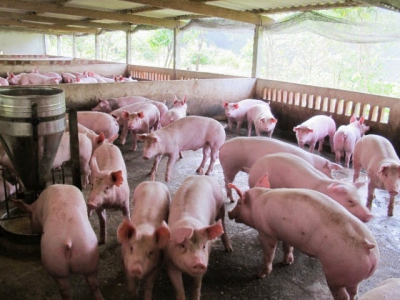Pork industry rallies in Vietnam, aquaculture sector robust

Feed demand in Vietnam is forecast to increase slightly, as the domestic pork industry rebounds and growth continues in the aquaculture sector, says the USDA.
Prices for pork and broilers have a great impact on local feed production in Vietnam, since pork accounts for 75% of total meat consumption and chicken accounts for 10%.
The latest USDA GAINS report on Vietnam shows both pork and poultry prices have increased steadily in that country since November 2017, after falling to very low levels during the first 11 months of 2017.
The publication reports pork and chicken production costs range from VND 35,000-40,000 per kilo. In May 2018, pork prices reached VND 48,000 per kilo and broiler prices reached VND 40,000 per kilo.
The increase of pork and broiler prices is due the short supply of meat on the market, said the USDA.
“Sources report that after the crash of the animal husbandry sector in 2017, small scale (backyard) farms suffered severe losses, resulting in a vast closing of these businesses. Only large scale farms with an integrated farm-to-table model survived the crisis.
“Rising pork prices are now driving reinvestment in the hog sector, but the Ministry of Agriculture and Rural Development’s (MARD) Animal Husbandry Department has warned small-scale farmers not to resume their activities to avoid another market crash due to over-supply.”

Vietnam: Pig and broiler price trends
Feed wheat imports
For marketing year (MY) 2017/18, the author of the report has revised upwards Vietnam’s wheat import volume from 4.2 MMT to 4.5 MMT, an increase of 300,000 MT compared to the USDA official estimate.
The increase is mainly due to the increased importation of feed wheat, due to competitive prices rom Eastern European sources, primarily from Russia.
The forecast for MY 2018/19 wheat import volume remains unchanged from the USDA official forecast.
“Vietnam continues to have strong demand for wheat from the livestock and aquaculture industry. The important factor for buyers choosing between feed wheat and other feed ingredients is wheat’s selling price compared to corn. Recently, feed wheat prices have been moving with corn prices, and since mid-2016, wheat has been running lower or at nearly the same level as corn. At similar prices, millers prefer feed wheat due to a variety of elements, including protein content, color, and binding factors. These price dynamics have resulted in the large volumes of feed wheat imports into Vietnam.”
The report noted that, recently, wheat imports into Vietnam from Australia have been decreasing, while there has been a large increase in Russian imports. By the first 6 months of CY18, or the second half of MY 2017/18, Russia became the largest supplier of wheat - mainly feed wheat - into Vietnam, while Australia fell to second.
For MY 2018/19, the GAINS report forecasts corn imports at 11 MMT, a 1 MMT increase over the USDA official number, due expected steady growth in the animal husbandry industry.

Wheat imports into Vietnam
DDGS imports
The US continues to be the dominant supplier of DDGS to the Vietnam market.
After the import suspension of US origin DDGS was lifted in September 2017, imports have strongly rebounded due to the high demand from the domestic feed industry, noted the report.
DDGS are used for both an energy and protein source in feed.
In MY 2017/18, import volumes of DDGS are estimated at 690,000 MT and are forecasted to rise to 1.0 MMT in MY 2018/19.
Có thể bạn quan tâm
Phần mềm

Phối trộn thức ăn chăn nuôi

Pha dung dịch thủy canh

Định mức cho tôm ăn

Phối trộn phân bón NPK

Xác định tỷ lệ tôm sống

Chuyển đổi đơn vị phân bón

Xác định công suất sục khí

Chuyển đổi đơn vị tôm

Tính diện tích nhà kính

Tính thể tích ao hồ



 First Son La longan week underway in Hanoi
First Son La longan week underway in Hanoi  Bến Tre rice farmers switch to other crops
Bến Tre rice farmers switch to other crops